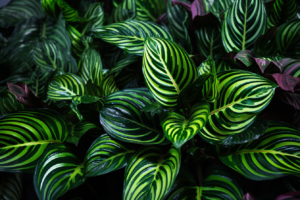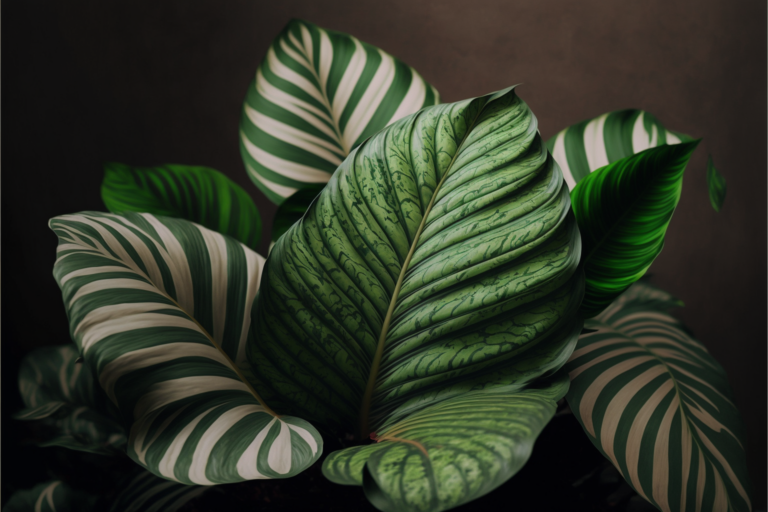We all love the striking patterns and lush foliage of the Calathea plant. Their beauty can brighten up any living space, but they also require proper care to thrive. One critical aspect of Calathea care is watering. In this article, we will discuss how often to water Calathea and provide valuable tips for keeping your plant happy and healthy.
Understanding Calathea’s Watering Needs
The Importance of Proper Watering
Calatheas are sensitive plants that need the right balance of water to thrive. Too much water can lead to root rot, while too little water can cause the leaves to wilt or curl. It’s crucial to understand your Calathea’s specific watering needs to keep it vibrant and healthy.
Factors Affecting Watering Frequency
Several factors influence how often you should water your Calathea, including:
- Pot size: Smaller pots dry out faster than larger pots.
- Soil composition: Well-draining soil retains moisture better than other types.
- Humidity: Higher humidity levels can reduce the need for frequent watering.
- Temperature: Warmer temperatures may cause the soil to dry out more quickly.
- Plant size: Larger plants generally require more water than smaller ones.
Keep these factors in mind when determining the best watering schedule for your Calathea.
How Often to Water Calathea?
Check the Soil Moisture
Before watering your Calathea, it’s essential to check the soil moisture. Insert your finger about an inch into the soil to feel for dampness. If the soil feels dry, it’s time to water.
Water Thoroughly
When watering your Calathea, ensure the water reaches the roots by saturating the soil. This process may require several applications of water to ensure even distribution.
Drain Excess Water
Calatheas don’t like sitting in water, so make sure to empty the saucer after watering to prevent root rot.
Maintain Consistency
Aim to keep the soil consistently moist but not soggy. This balance will prevent the roots from sitting in water while also preventing the leaves from drying out.
Adjust Your Watering Schedule
The frequency of watering your Calathea will vary depending on the factors mentioned earlier. In general, it’s best to water every 7-10 days during the growing season (spring and summer) and every 2-3 weeks during the dormant season (fall and winter).
Calculating the Ideal Watering Schedule
When it comes to watering Calathea plants, over-watering is a common mistake that many plant owners make, leading to root rot and other health issues. To avoid this, it’s crucial to calculate the ideal watering schedule based on your specific plant’s needs.
Here are some factors to consider to help determine the ideal Calathea watering schedule:
- Type of Calathea: Different types of Calathea have different watering needs. For example, Calathea Orbifolia needs to be watered more frequently than Calathea Lancifolia due to its thinner leaves.
- Humidity: Calathea plants prefer a humid environment and need to be watered more often in dry climates or dry indoor spaces.
- Light Exposure: Calathea plants will need more frequent watering if they are exposed to more light, as the light will cause the soil to dry out more quickly.
- Size of Pot: The size of the pot also affects the watering needs of the plant. Smaller pots may need to be watered more frequently since they have less soil to retain moisture.
To calculate the ideal watering schedule for your Calathea, follow these steps:
- Check the moisture level of the soil by sticking your finger into the soil up to the second knuckle. If the soil feels dry, it’s time to water.
- Water your Calathea until the soil is evenly moist but not waterlogged. Make sure to drain any excess water from the saucer.
- Track the timing of when the soil dries out and needs to be watered again. This will help you determine how often you should water your Calathea.
As a general guideline, Calathea plants should be watered every 1-2 weeks, but this can vary depending on the factors mentioned above. Use this guide as a starting point and adjust accordingly based on your specific plant’s needs.
Overall, calculating the ideal watering schedule for your Calathea can take some trial and error, but with patience and observation, you’ll be able to provide your plant with the perfect amount of water for optimal growth and health.
Different Watering Methods for Calathea Plants
When it comes to watering Calathea plants, it’s important to keep in mind that these tropical plants require consistent moisture without being waterlogged. Here are some different watering methods you can use to ensure your Calathea thrives:
- Top Watering: This is the most common watering method, simply using a watering can to pour water onto the surface of the soil until it drains out from the bottom of the pot. This method is ideal for small to medium-sized plants.
- Submerging: Some people prefer to submerge the entire pot in a sink or bathtub filled with water, allowing the soil to absorb water through the drainage hole. This method can be helpful for larger plants that are difficult to water from the top without causing soil erosion.
- Bottom Watering: For this method, you can simply fill a container with water, place the pot inside, and allow the soil to soak up water through the drainage hole. This method is ideal for plants that prefer consistently moist soil.
- Self-Watering: Another option is to use a self-watering pot or a wicking system, which allows the plant to absorb water as needed through a wick or tube from a reservoir. This method can be particularly helpful for those who tend to overwater or underwater their plants.
Regardless of the watering method you choose, it’s important to always check the soil moisture level before watering. Stick your finger about an inch deep into the soil and water only when the top inch feels dry. Overwatering can lead to root rot and other issues, so it’s best to err on the side of underwatering rather than overwatering.
In this section, I’ll cover how to water Calathea in different seasons so that you can keep your plant healthy all year round. Calathea plants, like many tropical plants, are sensitive to changes in temperature and humidity, which will affect their watering needs.
How to Water Calathea in Different Seasons
Spring and Summer
During the warmer months of the year, your Calathea plant will require more frequent watering. Check the soil with your finger every few days and water the plant when the top inch of soil is dry to the touch. In general, you should aim to keep the soil consistently moist, but not waterlogged. Overwatering can lead to root rot, so it’s better to err on the side of underwatering.
Fall and Winter
As the temperature drops and the air becomes drier in the fall and winter, you’ll need to adjust your watering routine. Depending on where you live, you may need to water your Calathea less frequently during this time. Check the soil with your finger every 4-5 days and water the plant when the top inch of soil feels dry. Do not let the soil dry out completely, but make sure that you are not overwatering.
Watering Tips for Healthy Calatheas

Use Filtered or Distilled Water
Calatheas are sensitive to chemicals found in tap water. To prevent leaf browning or curling, use filtered or distilled water when watering your plant.
Consider Your Calathea’s Specific Needs
Different Calathea varieties may have slightly different watering requirements. Research your specific plant variety to tailor your watering schedule accordingly.
Monitor Your Plant’s Health
Keep an eye on your Calathea’s leaves to detect any signs of under- or over-watering. Adjust your watering schedule as needed to maintain the plant’s health.
Conclusion
Understanding how often to water Calathea is essential for maintaining a healthy, beautiful plant. By following the guidelines and tips provided in this article, you can ensure your Calathea receives the proper care it needs to thrive.
FAQs
Can I use tap water for my Calathea?
It's best to use filtered or distilled water for your Calathea , as they are sensitive to chemicals found in tap water. These chemicals can cause leaf browning or curling.
How do I know if I’m over-watering my Calathea?
Signs of over-watering include yellowing leaves, a musty smell, and black or mushy roots. To prevent over-watering, ensure the soil is consistently moist but not soggy and always drain excess water after watering.
What should I do if my Calathea’s leaves are curling?
Curling leaves can be a sign of underwatering or exposure to chemicals in tap water. Check the soil moisture and adjust your watering schedule accordingly. If you're using tap water, switch to filtered or distilled water.
How can I increase humidity for my Calathea?
You can increase humidity by placing a tray filled with water and pebbles under the pot, misting the leaves regularly, or using a humidifier in the room where your Calathea is located.
Do all Calathea varieties have the same watering requirements?
While most Calatheas have similar watering requirements, some may have slightly different needs. Research your specific variety to ensure you provide the appropriate care.

